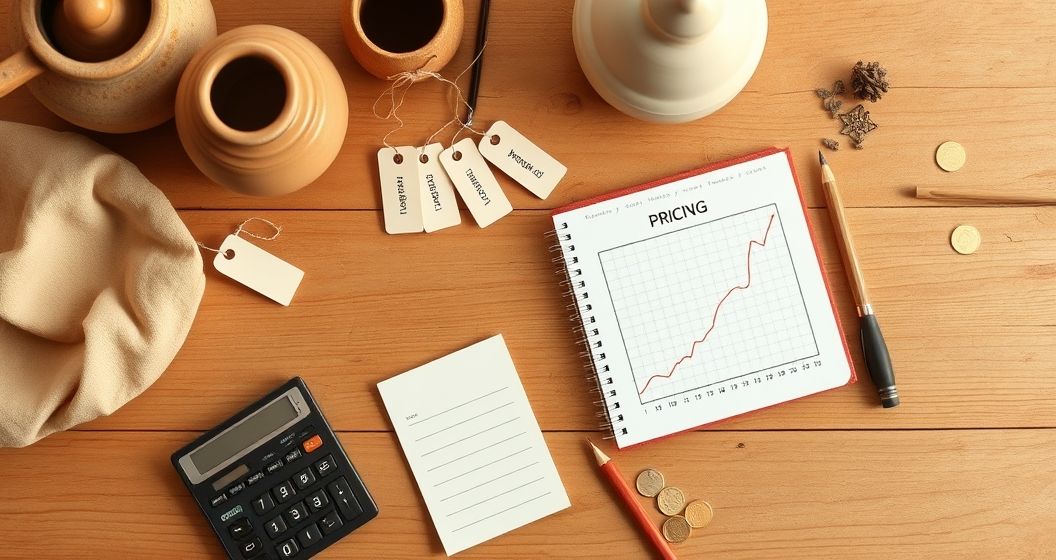Setting the right price for your Etsy products is one of the most critical decisions you will make as a seller. An effective pricing strategy goes beyond simply covering your costs; it reflects your brand’s value, positions you within the market, and ultimately determines your shop’s profitability and long-term success. Many creators struggle with this balance, either undervaluing their work or pricing themselves out of the market. This guide provides a clear framework to help you develop a comprehensive Etsy pricing strategy that builds confidence and drives sales.
What is an Etsy Pricing Strategy?
An Etsy pricing strategy is a methodical approach to determining the monetary value of the items in your shop. It is not about picking a random number but involves a careful calculation of all associated costs, an understanding of market dynamics, and a clear vision for your profit goals. A strong strategy ensures every sale contributes positively to your business. It considers tangible expenses like materials and fees, intangible factors like your time and skill, and external forces such as competitor pricing and customer perceived value, creating a sustainable financial model for your creative business.
1. Calculate Your Total Costs Accurately
The foundation of any solid Etsy pricing strategy is a thorough understanding of your expenses. Failing to account for every cost can quickly erode your profits. This calculation should be detailed and honest, covering every penny spent to create and sell your product. Breaking these costs down into distinct categories ensures nothing is overlooked. This initial step is non-negotiable for building a profitable shop and forms the baseline from which all other pricing decisions are made. A clear cost analysis prevents you from unintentionally losing money on your sales.
Material and Supply Costs
Begin by listing the cost of all raw materials used to create a single item. This includes primary components as well as smaller items like thread, glue, or paint. Don’t forget to factor in the cost of packaging materials, such as boxes, bubble wrap, tissue paper, and thank-you cards. To get an accurate per-item cost, divide the total cost of a bulk supply by the number of units you can produce from it. This detailed accounting ensures that the physical components of your product are fully covered in the final price.
Labor and Time Investment
Your time and skill are valuable assets and must be included in your product pricing. Determine a fair hourly wage for yourself based on your expertise and the complexity of the work involved. Track the amount of time it takes to create one product, from initial design to final packaging. Multiply your hourly wage by the hours spent to find your labor cost. Many new sellers make the mistake of not paying themselves, which is an unsustainable business practice. Valuing your labor is crucial for a healthy Etsy pricing strategy.
Etsy Fees and Overhead
Operating an Etsy shop involves several fees that must be factored into your pricing. These include listing fees, transaction fees, payment processing fees, and optional offsite ad fees. Additionally, consider your general business overhead, such as the cost of tools, software subscriptions, marketing expenses, and workspace utilities. Tally these monthly or annual overhead costs and divide them by your expected number of monthly sales to assign a small portion of overhead to each item’s price, ensuring all business expenses are covered.
2. Research the Market and Competitors
Once you understand your costs, the next step is to analyze the marketplace. Researching what similar products are selling for on Etsy provides critical context for your pricing. This is not about copying your competitors but about understanding the established price range and customer expectations for your product category. A thorough market analysis helps you position your brand effectively, whether you aim to be a budget-friendly option, a mid-range standard, or a premium, high-value provider. This insight is essential for a competitive Etsy pricing strategy.
Look for sellers who offer products of similar quality, style, and complexity. Pay attention to their pricing, but also analyze their photos, product descriptions, and reviews. A competitor charging a higher price might be justifying it with superior photography, more detailed descriptions, or a stronger brand presence. Conversely, a lower-priced item might lack the quality or refinement of your work. Use this information to identify where your products fit and how you can communicate their unique value to justify your chosen price point.
3. Choose a Core Pricing Model
With your costs calculated and market research complete, you can now select a formal pricing model. A structured formula removes guesswork and provides a consistent approach across all your products. The right model will depend on the nature of your items, your brand positioning, and your financial goals. Using an established model also makes it easier to explain your pricing if customers ask and helps you maintain consistent profitability. We will explore three common and effective models for an Etsy pricing strategy.
Cost-Plus Pricing
This is the most straightforward pricing model. The formula is simple: Total Costs + Desired Profit Margin = Price. After adding up your material, labor, and overhead costs, you add a markup percentage for your profit. For example, if your total cost to produce an item is $15 and you want a 100% markup (a common starting point for handmade goods), your profit would be $15, making the wholesale price $30. You might then double that again for a retail price of $60. This model guarantees you make a profit on every sale.
Value-Based Pricing
Value-based pricing is ideal for highly unique, artistic, or specialized products where the cost of materials does not reflect the item’s true worth. Instead of focusing on costs, this model sets prices based on the perceived value to the customer. This value can be derived from exceptional skill, a one-of-a-kind design, brand reputation, or the story behind the product. An artist selling a unique painting, for example, prices it based on their talent and the piece’s originality, not just the cost of canvas and paint. This model requires strong branding to be successful.
4. Factor in Shipping Strategically
Shipping costs are a significant factor in a customer’s decision to purchase. Your Etsy pricing strategy must include a clear and thoughtful approach to shipping. Customers are often drawn to the appeal of “free shipping,” but it’s important to remember that shipping is never truly free. The cost must be absorbed somewhere, which typically means incorporating it into the product’s overall price. This can increase the item’s perceived value and reduce cart abandonment, as there are no surprise fees at checkout.
To offer free shipping, calculate your average shipping cost and build it into the item price. For example, if your product price is $40 and shipping typically costs $8, you would list the item for $48 with free shipping. Alternatively, you can offer calculated shipping, where Etsy determines the cost based on the buyer’s location and the package’s weight and dimensions. This approach is more transparent but may deter customers who are sensitive to additional fees. Test both methods to see which works best for your audience and profit margins.
Conclusion: Pricing with Confidence
Developing a successful Etsy pricing strategy is a dynamic process that blends methodical calculation with market awareness. By meticulously calculating all your costs, including materials, labor, and fees, you create a solid financial foundation. Layering this with insightful market research and a deliberate pricing model allows you to position your products effectively. Finally, a strategic approach to shipping ensures you meet customer expectations without sacrificing your profitability. This comprehensive approach empowers you to price your items with confidence, ensuring your creative passion evolves into a thriving and sustainable business.






